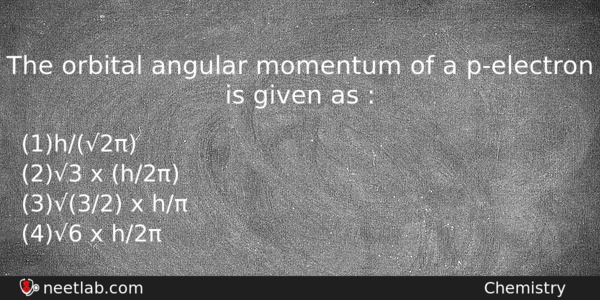| ⇦ | 
| ⇨ |
The orbital angular momentum of a p-electron is given as :
Options
(a) h/(√2π)
(b) √3 x (h/2π)
(c) √(3/2) x h/π
(d) √6 x h/2π
Correct Answer:
h/(√2π)
Explanation:
Orbital Angular Momentum = h/(2π) x √(l(l+1)). For p orbital, l=1. so => h/(2π) x √2 =? h/(√2π)
Related Questions: - A 20 mass percent H₂SO₄ solution has density 1.15 g mL⁻¹.Molarity
- The constituents of porland cement are
- Among the following the paramagnetic one is
- Which of the following has ability to release bromine from potassium bromide
- The most acidic among the following is
Question Type: Memory
(964)
Difficulty Level: Easy
(1008)
Topics: Structure of Atom
(90)
Subject: Chemistry
(2512)
Important MCQs Based on Medical Entrance Examinations To Improve Your NEET Score
- A 20 mass percent H₂SO₄ solution has density 1.15 g mL⁻¹.Molarity
- The constituents of porland cement are
- Among the following the paramagnetic one is
- Which of the following has ability to release bromine from potassium bromide
- The most acidic among the following is
Question Type: Memory (964)
Difficulty Level: Easy (1008)
Topics: Structure of Atom (90)
Subject: Chemistry (2512)
Important MCQs Based on Medical Entrance Examinations To Improve Your NEET Score
18000+ students are using NEETLab to improve their score. What about you?
Solve Previous Year MCQs, Mock Tests, Topicwise Practice Tests, Identify Weak Topics, Formula Flash cards and much more is available in NEETLab Android App to improve your NEET score.
Share this page with your friends

Leave a Reply